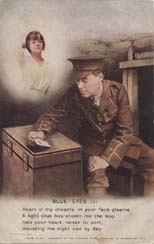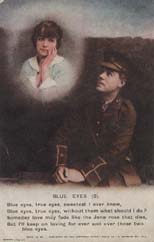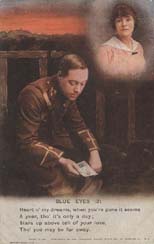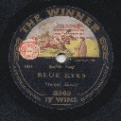Blue Eyes
-s.jpg) |
 |
 |
 |
Words by Fred Godfrey as “Godfrey Williams,” music by Lawrence Wright as “Horatio Nicholls”; American Society of Composers, Authors and Publishers (ASCAP) lists as Godfrey & Nicholls; EMI lists Godfrey as “Geoff Williams” & Wright as “Horatio Nicholls — London: Lawrence Wright Music; Bert Feldman, 1915 [ASCAP lists publisher as EMI April Music Corp]; New York: F.B. Haviland, 1919 [as Those Two Blue Eyes]; copyright renewed by Godfrey & Wright, 1943 [Library of Congress].
.
* * * * * * * * * * * *
 |
Listen
to a |
.gif) |
Fred Godfrey’s youngest daughter Peggie (1912–2001, the author’s mother), who had blue eyes, always claimed he wrote the song for her — she would have been about two and a half years old at the time. Below are some enthusiastic reviews of this popular waltz number.
“A ballad that has suddenly come into prominence is ‘Blue Eyes,’ which a month ago was unheard of. To-day it is in the repertory of many concert ballad vocalists” (The Stage, 10 June 1915, p. 23).
“‘You can lead a horse to water but you cannot make him drink,’ is an old proverb which might be varied to read, ‘You can give an artist a song but you cannot make him sing it.’ The most powerful publishers cannot force a song. ‘Hits’ happen—they are not made. ‘Blue Eyes’ is being sung by many ballad singers; and though they have had hundreds of songs to choose from this season, the exquisite charm of ‘Blue Eyes’ has apparently attracted them. Kitty Dale wrote last week from the Grand, Birmingham, as follows: ‘I produced ‘Blue Eyes’ at the above hall last night, and I am delighted to tell you I made a big success with it. I think it is a charming song.’” (The Stage, 24 June 1915, p. 23)
“The success of Lawrence Wright’s latest ballad, ‘Blue Eyes,’ is a subject of much talk in vaudeville circles just now. It is expected that the sales will reach the half-million mark, and it is said that another publishing firm has offered £2,000 for the rights” (“Variety Gossip,” The Stage, 15 July, 1915, p. 18). “It is stated that the pen name of ‘Godfrey Williams’ (part composer of the popular ballad ‘Blue Eyes’) covers the identity of Fred Godfrey” (“Variety Gossip,” The Stage, 29 July, 1915, p. 15). How much of the windfall came Godfrey’s way?
Blue Eyes is particularly associated with Dorothy Ward: “Miss Dorothy Ward’s choice of song is usually followeed with keen interest by all the stars of the pantomime world, and the fact that this ideal principal boy has picked for her big ballad the one and only ‘Blue Eyes’ should erase any doubts as to which is the best ballad of the year” (The Era, 22 December 1915, p. 26). Many others sang it, too. Indeed, a Lawrence Wright Music promotional writeup in The Stage (3 June 1915, p. 16) says the song was first sung by soprano Florence Smithson. Here are some others who helped make Blue Eyes practically ubiquitous, despite the war:
Beatrice Allen and Harry Geale in the John Tiller revue The Swiss Miss (Elephant and Castle, London (1915); Bernard Ash Quartet, Palace, Blackpool (May 1915), Grand, Bolton (August 1915); Frank Bevan in revue Away Down South, Ashton-under-Lyne (September 1915): “‘Blue Eyes’, no matter where it is sung, is successful. Further testimony to this fact was contained in a letter from Frank Bevan, the baritone of Away Down South company,...in which he says... ‘I put [‘Blue Eyes’] on last night and made and made an instantaneous ‘hit’. It is really the best song I have ever sung’” (“Song Notes,” The Stage, 9 September 1915, p. 18).
Harold Browne of Fred Allandale’s Pierrots, Central Pier, Blackpool (May 1915); Dorothy Craske in pantomime Cinderella, Kennington, London (December 1915); Milly Craven, Palace, Salisbury (July 1915); Doris Earle in the revue Seconds Out (Metropolitan, London (1915); Burt Errol, at the Hippodrome, Bristol, and London Coliseum (September 1915); Evelyn Grace, Winter Garden, Blackpool (May 1915); Nancie Hanson in pantomime The Babes In The Wood, Royal, Glasgow (December 1915); Emilie Hayes (wife of G.H. Elliott), Empire, South Shields (July 1915); Garforth Mortimer’s Blue Anglaiso Orchestra, Victoria Pier, Blackpool (August 1915); Grace Scarboro in Campbell and Mostel’s revue What A Beauty (1915); and Carlotta Silvano in revue September Morn (1915).
“Corporal T. O’Callaghan writes from ‘Somewhere in France’: ‘On behalf of our concert party I wish to thank you for the splendid batch of songs [Feldman & Co.] sent me. ‘Blue Eyes’ has already become a craze, and I am sure it will soon be all over France’” (“Song Notes,” The Stage, 11 November 1915, p. 26).
Recordings
Black Diamonds Band, in “Camp Concert” (Zonophone Twin 1572, 1915)
The Bohemian Band (Edison Bell Winner 2912, 1915)
Stanley Kirkby (Clarion 915, 1915 [cylinder]; John Bull 554; Jumbo 1311, 1915; The Winner 2863, 1915; The Winner 2921 [reissue?], 1915; Clarion 109, 1916; Clarion 129, 1916)
The Mayfair Orch.; dir. by George W. Byng (HMV C-624, 1915)
Murray Johnson (HMV B-549, 1915)
Will Thompson (Popular 596, 1915)
Dorothy Ward (Regal G-7170, 1915)
The New Mayfair Dance Orch., in “Memories Of Horatio Nicholls” (HMV B-280, 1935)
Debroy Somers Band, in “Memories of Horatio Nicholls” (Columbia DX-673, 1935)
Charlie Kunz, in “Charlie Kunz’ Twenties Waltz Medley” (Decca F-9904, 1952); reissued on LP “Charlie Kunz Piano Medley No. 4” (London LB 678, 1952?)
Clarence Wright, in 7-LP set “Palace Of Varieties — Old Time Music Hall” (BBC CN-1426, 1976)
Harry Davidson & His Orch. (Columbia SCD 2033)
